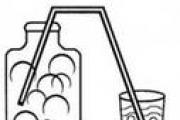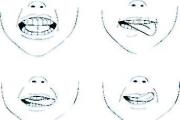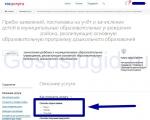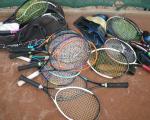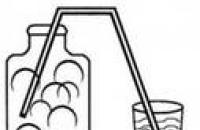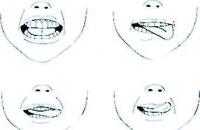Surely many of you remember the openwork napkins that your grandmother once knitted. Or maybe someone was luckier and had some in their wardrobe summer dresses with elements of such knitting? To learn how to create the same things, we will look at crocheting double crochets.
As a rule, double crochets are several times higher than single crochets. Accordingly, this method is much faster. Most often, this knitting is used to create small lace products, for patterns or for individual elements. After all, they turn out airy. You can also create not only patterns, but also sweaters, scarves, capes, and summer dresses.
To begin with, we will need a hook, yarn, patience and existing stitch knitting skills. Below we will look at the step-by-step creation of mating.
Knitting the base
Let's leave a small tail with which the main thread of yarn will intersect. Next we see the loop formed. We lift the tail up. Thus, he divides the loop in half. We insert the hook from below so that the tail is under it. And our loop will be on top. Then we pull the hook down and parallelly pull the end of the thread and its main part in different directions. As a result, we got a loop from which we can make a tight knot. Which, in fact, is what we needed.
So, we already have a knot with a loop. Next, we transfer the main thread to the index finger, and pinch the tail with the middle and thumb.

We hook the hook onto the main thread, hook it and pull it through the loop we made in the last step. Thus, we created an air loop.

We carry out these actions until there is no required amount loop. Always count the already connected loops, so that later the question does not arise as to why it does not work out, as in the diagram.
Remember that the first one we created with the knot counts as the first loop in your chain. For example, if you need to knit fifteen loops, then take into account that one is already there and knit the missing fourteen.

Creating columns
We already have the required number of loops. Let's knit a couple more pieces. These will be lifting loops. You need to count them like the first column. Those who knit with double crochets (designated in verbal form - C2H) need to make three lifting air loops.

When you reach the last loop, you need to unroll the chain. This way you will knit from the end of the side of the previous row, and the last stitches will be at the beginning of the product. After all, crochet is done from right to left.

We need to create two yarn overs. How do we do this? Very simple. Make sure that the working thread is behind the hook. Then we wrap the hook twice around the working thread. Well, the yarn overs are ready.

We count the fifth loop from the hook and insert a hook with two crochets into it.

The photo shows that there are four loops on the hook. We did it this way: we hooked the working thread, pulled it through the loop of our air braid and pulled it out.

We hook the working thread again and pull it through two loops on the hook. As a result, there are three loops on the hook. To create a double crochet stitch, the loops on the hook are knitted in pairs.

We repeat the action as in the previous step. Only now we should have two loops left on the hook

And finally, we hook the working thread and pull it through the end loops. Our column is ready.

Row with a common vertex
First we need to make several yarn overs.

Then insert the hook into the next loop.
We hook and pull the main thread through a couple of loops.

The steps are repeated until the end of our braid.

And in order to knit the next row, simply unfold the fabric. Thus, the last stitch will be at the beginning of knitting.

In addition to what is already on the hook, you will need to knit three more air loops, which will count as a stitch.


If you are mastering this master class, then you have already learned how to create with air loops different types columns. These basics will help you knit more complex fabrics, since basically many patterns are created thanks to air loops, double crochets and single crochets. At first you can practice on small items, and a little later master knitting larger items. The main thing is not to stop and develop your skills. Perhaps you have a talent you never knew you had. And now you are just beginning to open up.
Video on the topic of the article
To consolidate the material, we suggest watching a small selection of videos on knitting double crochets.
Double crochets are one of the most common and simplest stitches used in crochet. The height of the column depends on the number of yarn overs: the more there are, the higher the column. Double crochets are usually knitted “in a loop” (both half-loops). If the pattern provides for others, this is indicated additionally in the description. In this section: how to knit half double crochet, single crochet, double crochet stitch.
Let's see how to knit a half double crochet. As usual, start knitting with the initial chain of air loops. The first stitch is knitted into the third loop from the hook (2 lifting loops).
Yarn over.
Insert the hook into the loop of the previous row, grab the working thread and pull it through the loop. There are now 3 loops on the hook.

Next, pick up the thread with your hook and pull it through all three loops on the hook. This is precisely the difference between knitting half double crochets: the thread is pulled in one step, whereas when knitting other types of double crochets in several steps: each time only two loops are knitted.

Single crochet stitch
To knit the fabric in single crochet stitches, knit 2 lifting loops: the first stitch is knitted into the 3rd loop of a braid of air loops.
The photographs below show the step-by-step knitting of a single crochet stitch.
Yarn over.

Insert the hook into the loop, pick up the working thread: there are 3 loops on the hook.

Pull the yarn through the first 2 loops, now there are 2 loops on the hook again.

Once again, pick up the working thread and pull it through the loops remaining on the hook.

Double crochet stitch or more
Theoretically, a column can be knitted with any number of yarn overs. Double crochet stitches or more are knitted according to the same principle as single crochet stitches: the loops are knitted in pairs until one loop remains on the hook. Let's see how to knit such stitches using the example of a double crochet stitch. The first stitch is knitted into the 4th loop of the initial chain from the hook (3 lifting loops). The general principle for determining the required number of lifting loops is as follows: the number of lifting loops is equal to the number of yarn overs plus 1.
Make two yarn overs.

Insert the hook into the loop, grab the working thread and pull the loop through. There should be 4 loops on the hook.

Pick up the working yarn and pull it through the first two loops. There are 3 loops on the hook.

Pick up the working thread again and pull it through the next two loops. There are 2 loops on the hook.

Pick up the working yarn again and pull it through the last two loops. There is again only one loop on the hook.

The number of yarn overs determines the height of the column. In the photo: the first row of single crochets. the second row - with two, the third row - with three and the fourth row - with four yarn overs.

Let's continue learning the techniques of crocheting stitches. In addition to double crochets, there are also elements with a large number of crochets. If you have mastered the previous lessons well, then this one will not cause any problems.
In order to knit a double crochet stitch, at the beginning of the row you need to make four air loops for lifting.

Then, with a movement of your hand, throw the thread onto the hook twice.

And only after that, insert the hook into the loop of the previous row (or the chain loop of the initial row) and pull the working thread through it.



There will be four loops on the hook. they need to be knitted in pairs. That is, first, again throwing the working thread onto the hook, pull it through the loop and one yarn over.


Then yarn over again and pull through the newly formed loop and another yarn over.

And finally, through the last two loops remaining on the hook.

You can knit stitches with two (or more) double crochets using different half-loops, but the difference will not be as noticeable as for lower stitches.

A stitch with three crochets is knitted in a similar way, with the only difference being that you need to make five chain stitches for lifting, three yarn overs, and pairwise knitting of stitches will be completed with one more step. In general, there can be more yarn overs, and such stitches are knitted according to the same principle. The standard number of chain stitches for lifting is two more than the number of yarn overs.
Here are the patterns for knitting stitches with two and three crochets: 
Whole fabrics made from double crochets with two or more crochets are usually not knitted because they turn out loose and hardly hold their shape. But in openwork patterns, as individual elements, along with arches of air loops, picots and scallops, they look simply wonderful. But we’ll talk about openwork patterns and the principles of their knitting later.
Let's summarize. What can you do after mastering only seven lessons (strictly speaking, even six, if you don’t count the introductory one)?
Knit chain stitches and all main types of stitches. This means that you can do almost everything. Using these elements in various combinations, you can knit a great variety of patterns. The vast majority of crochet patterns - from the simplest to the most spectacular, from dense fabrics to the finest openwork - are crocheted with air loops, connecting stitches, single crochets, and double crochets (one, two or more).
Does this mean that the training is over? Only you yourself know the answer to this question. If you have consistently completed the lessons that I have offered you, you have learned the basics of crochet. This is enough to knit simple things, and - most importantly - not to be afraid. Now, having seen a description or diagram of even a complex (believe me, this is only at first glance!) pattern, you will not close the book or website page. Because you have the knowledge to help you figure it out. This is the basis. Everything else - tips, little tricks, descriptions of various knitting techniques - can be found in other sections of the site. Welcome to the big wonderful world of knitting!
This article is a continuation of a series of articles about the basic elements of crochet. Previous articles and. Today, a double crochet stitch, 3 and 4. And also their designation in knitting patterns.
Double crochet stitch.
Having knitted the chain, make two yarn overs on the hook one after the other, insert it into the 4th loop of the chain and, throwing a working thread over it, pull it through the loop of the chain.
Two loops and two yarn overs on the hook are knitted like this. First, by placing the working thread on the hook, pull it through the loop and the first yarn over on the hook. Then throw on the working thread and pull it through the loop and the second yarn over. Throwing the thread on again, pull it through the two loops remaining on the hook. When making stitches with three or more yarn overs, make the required number of yarn overs, and all the loops on the hook are knitted two together.
a stick crossed out twice, the letter “t” crossed out twice.
- interesting selection for the site!!!
- Only skirts for adults, nothing for children
double crochet stitch
Double crochet stitch with three and four crochets
If you knit a stitch with three, four or more crochets, the thread is thrown onto the hook as many times as the stitch you want to knit (three, four or more times, respectively). The hook is inserted into the loop of the chain, counting the number of loops from the edge; it should be two loops more than are on the hook. The thread is pulled alternately through every two loops on the hook until one loop remains on the hook. At the end of the row, lifting loops are made, two more than the number of yarn overs.

double crochet stitch
Designations on knitting patterns:
stick crossed out three, four, etc. one, the letter “t” crossed out three, four, etc. once
You already know how to make one yarn over a hook. This technique is discussed in detail in the lesson. To make the second yarn over, we simply repeat the yarn over procedure. In this case, we do not wind the thread from the ball around the hook, but, on the contrary, we draw the hook itself around the thread. We hold the thread taut with the fingers of our left hand.
We will study the lifting loops at the beginning of the row in detail in the lesson.
As a result of knitting, we got this pattern.
This pattern is most understandable for beginners in crocheting, as it clearly shows that on each loop of the chain there is one full double crochet stitch. Moreover, with this method of knitting, you clearly see the last loop of the row, into which the hook very easily fits. Knitting will never turn out skewed, because strict accounting is carried out here - each loop has its own full-fledged column.
When you learn to navigate this scheme well, you can move on to, which we will look at in the next lesson of our circle.
This concludes the lesson on knitting stitches with 2 crochets. Today we learned how to make a double crochet on a hook, how many steps it takes to build a double crochet stitch and learned its designation in crochet patterns.
Be sure to knit the pattern according to the pattern of this lesson, carefully study the arrangement of the columns, count the number of columns in each row.



















































 Next we repeat the steps 5 — 10.
Next we repeat the steps 5 — 10.




